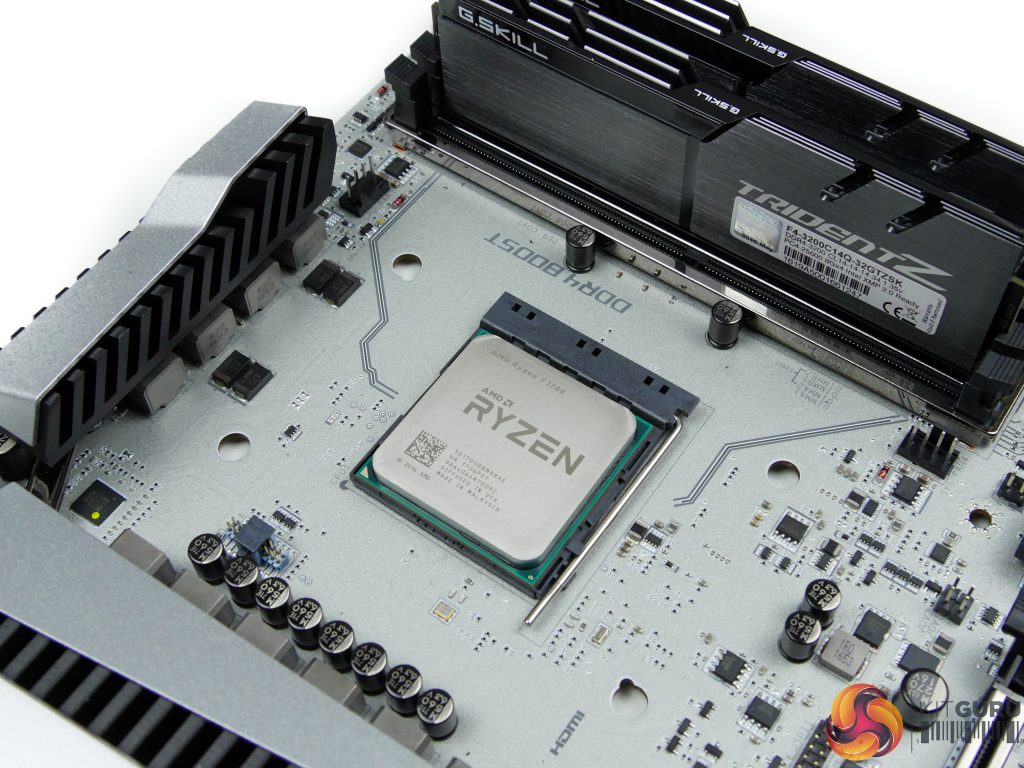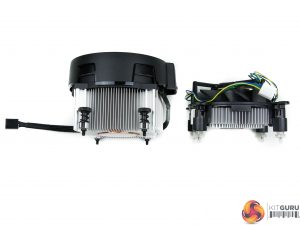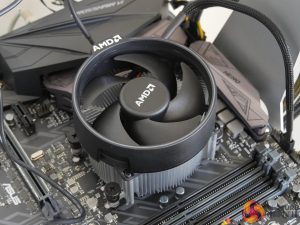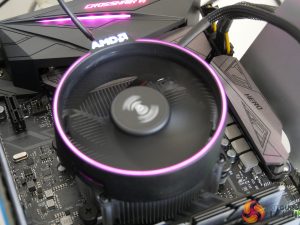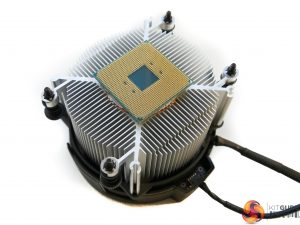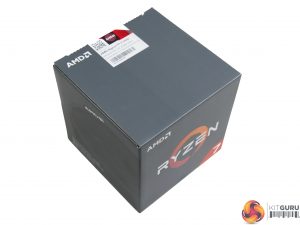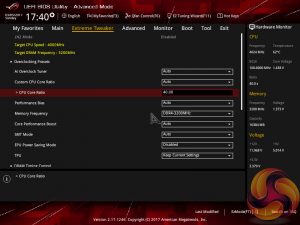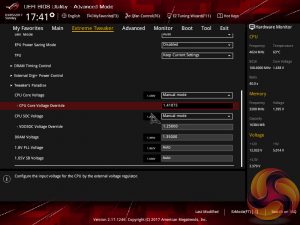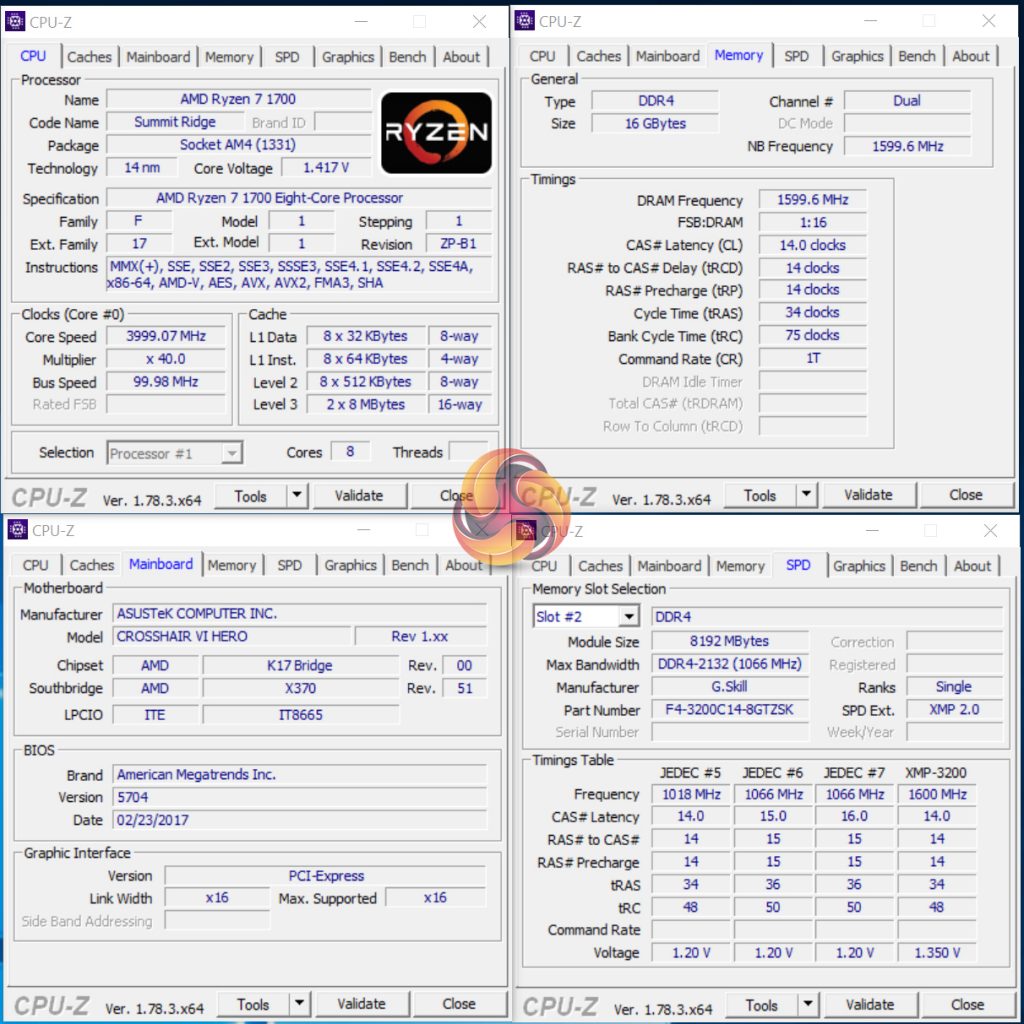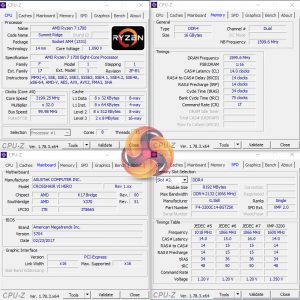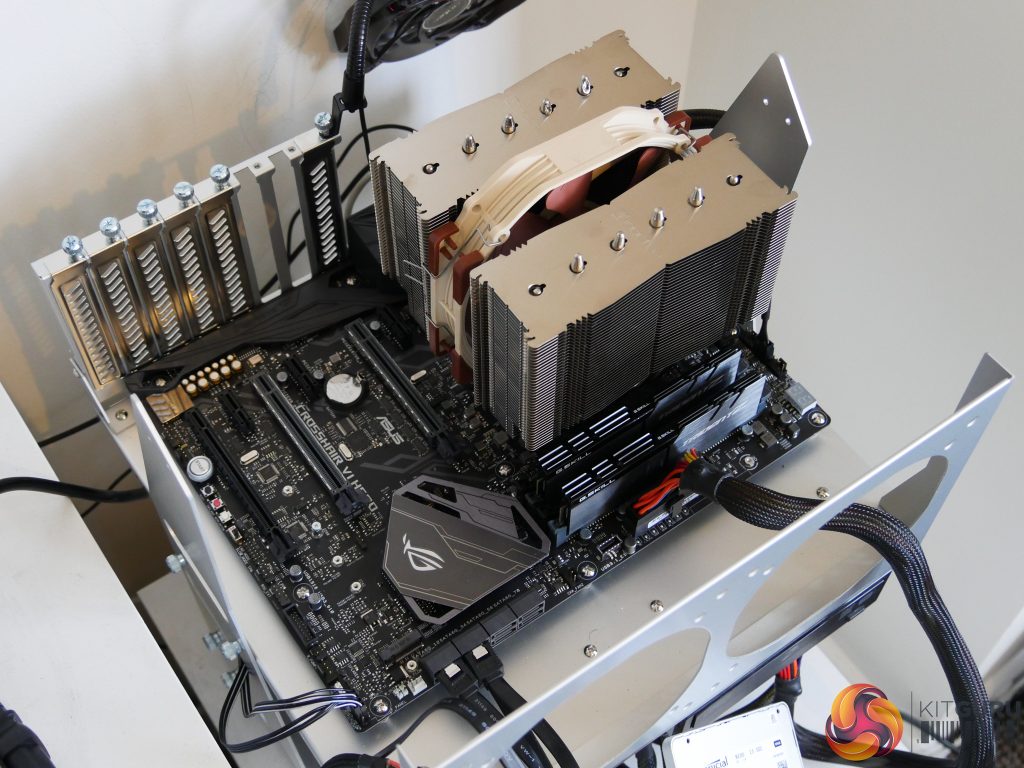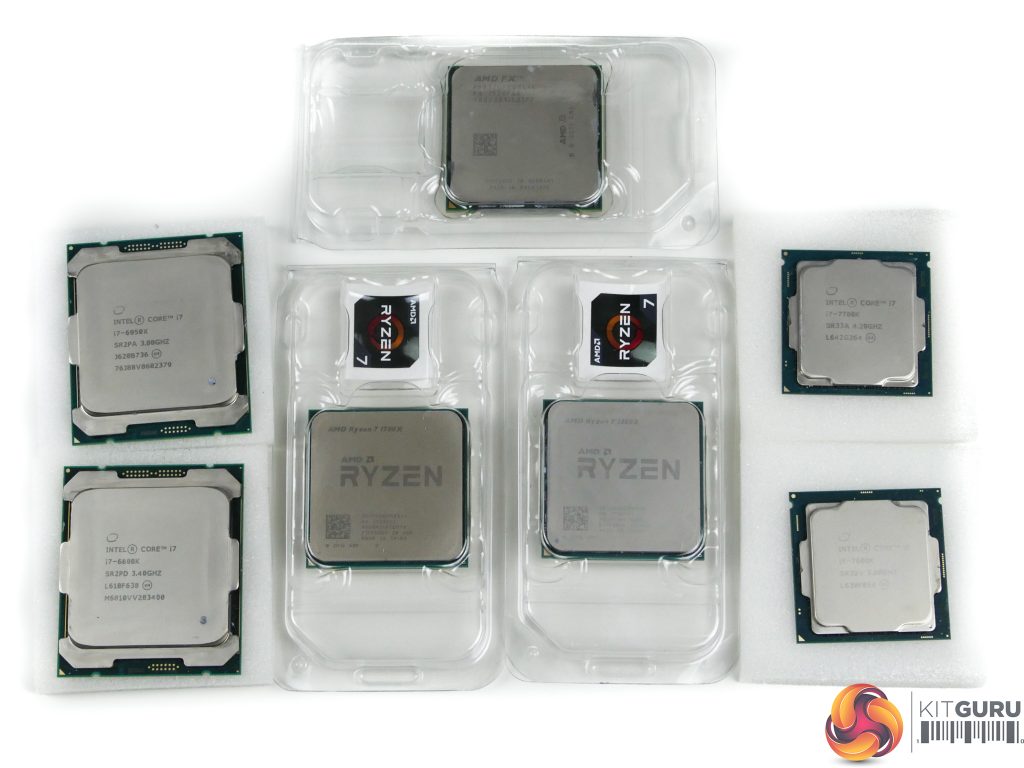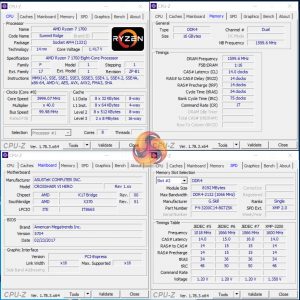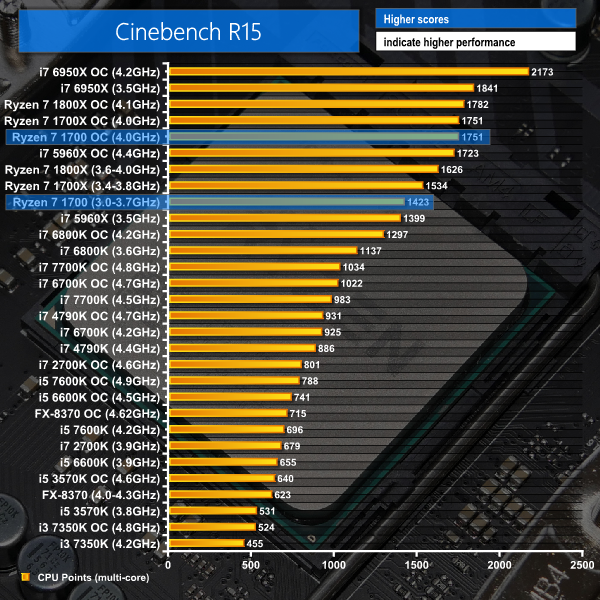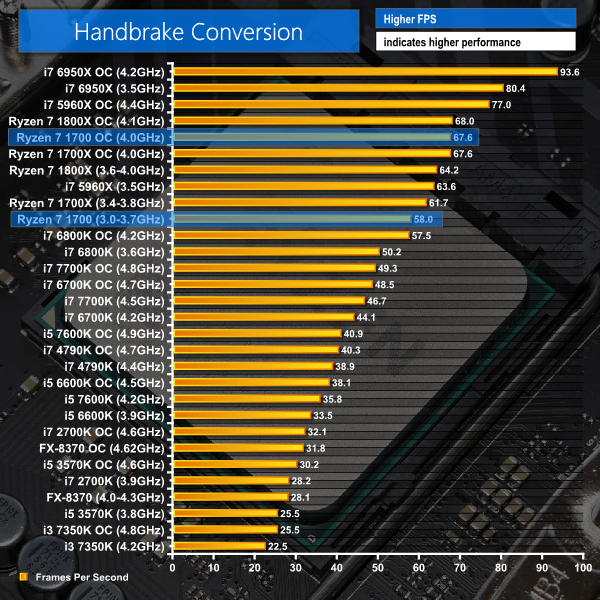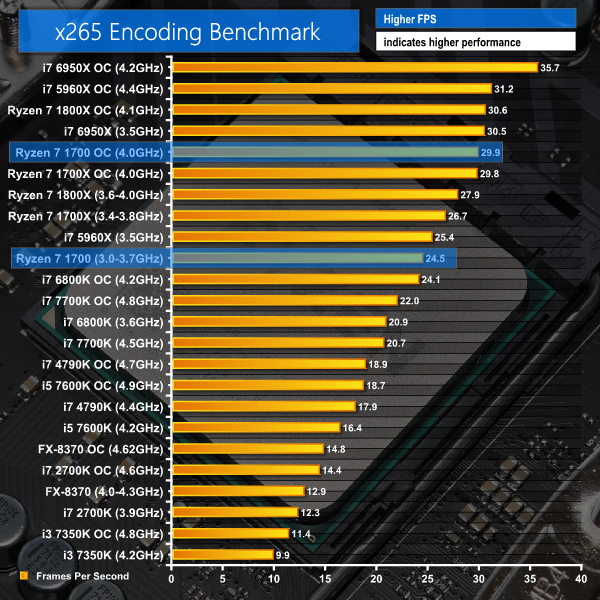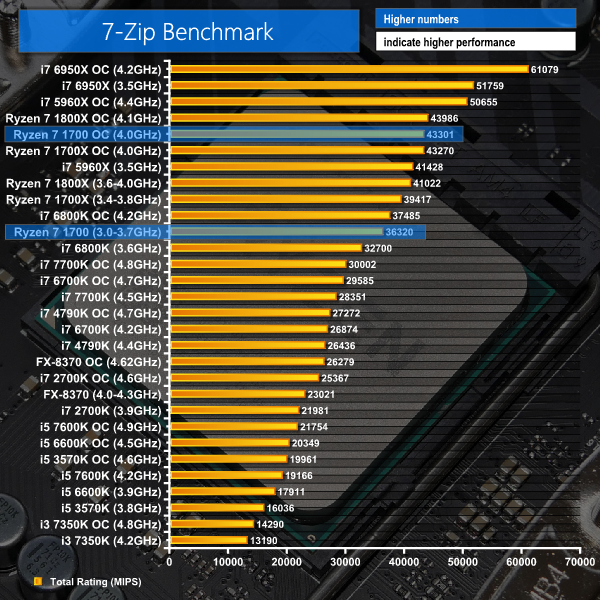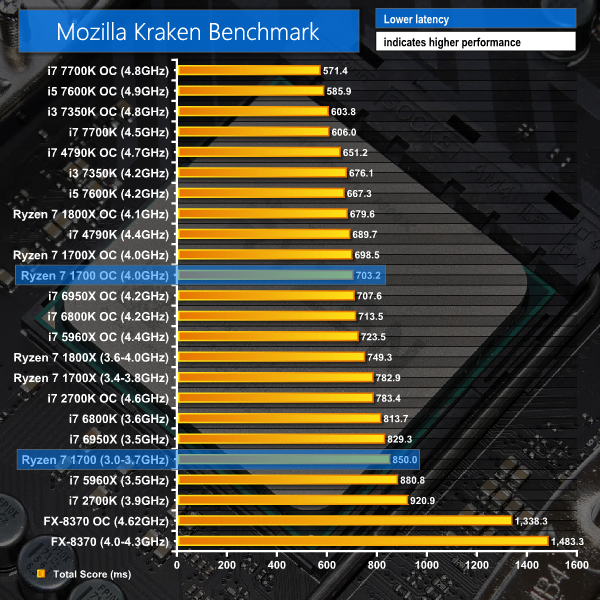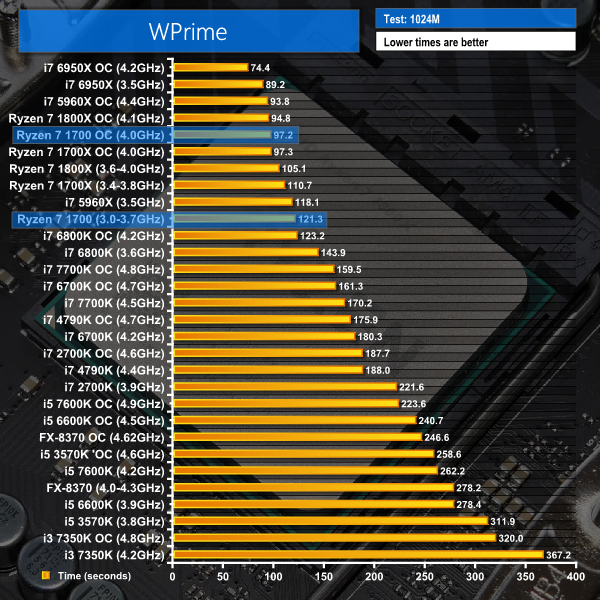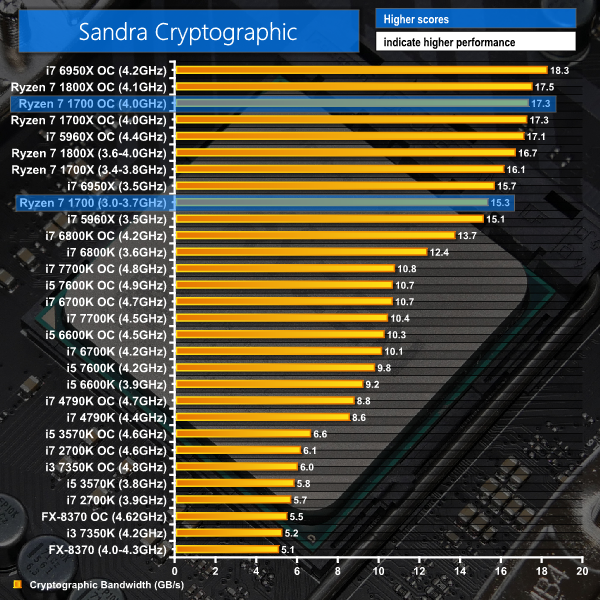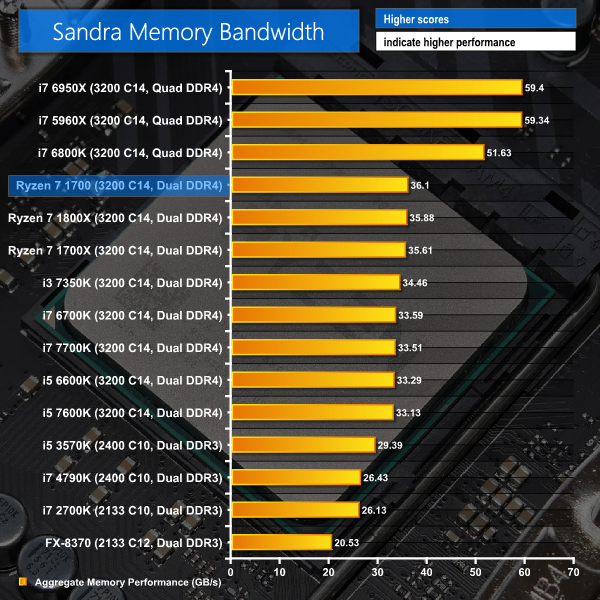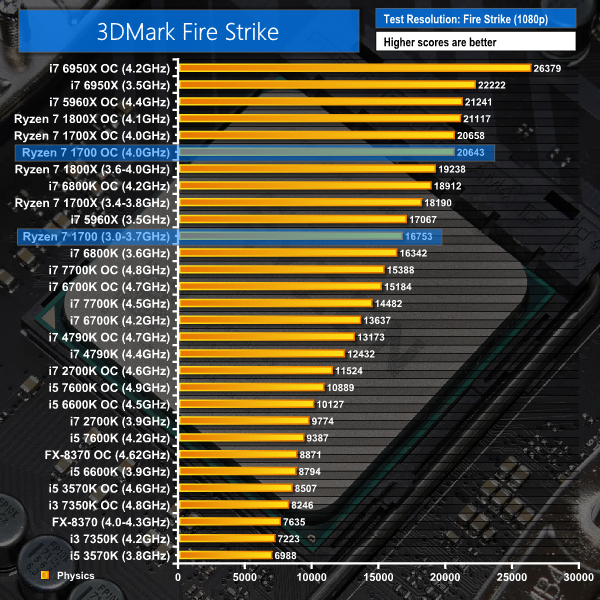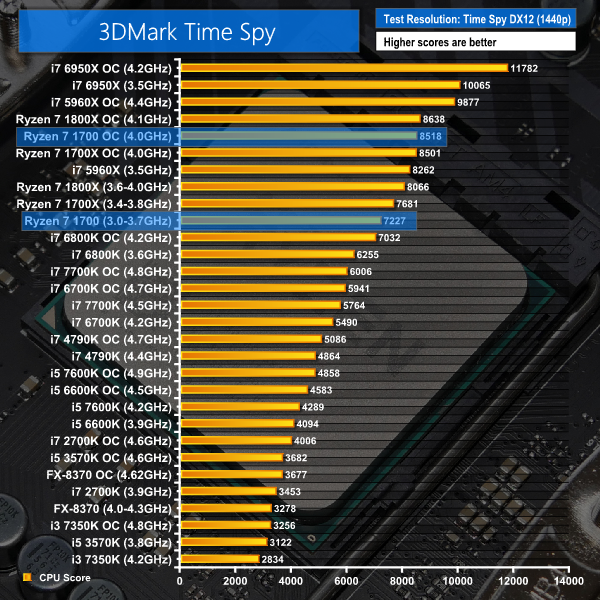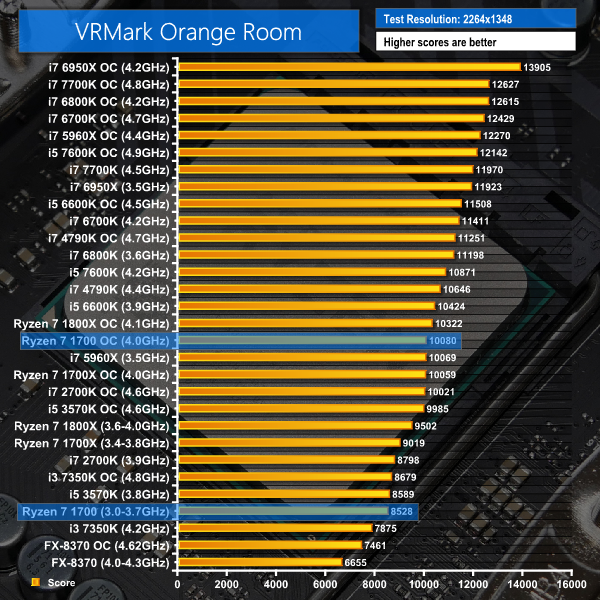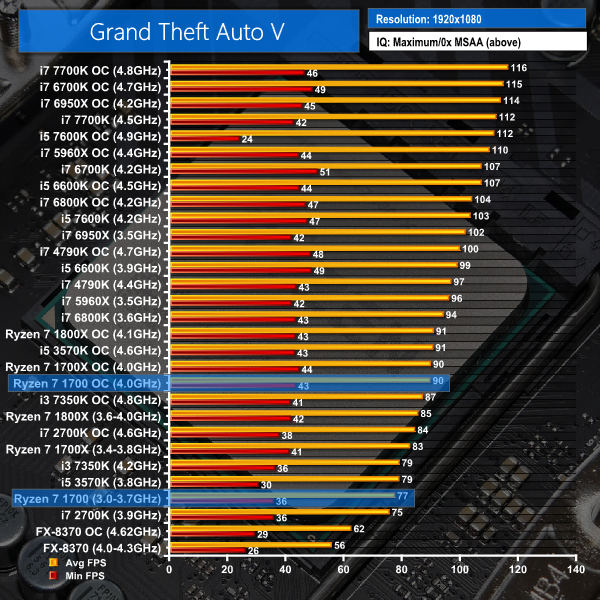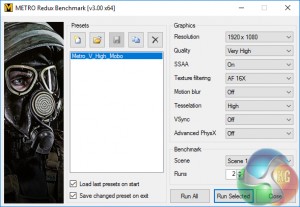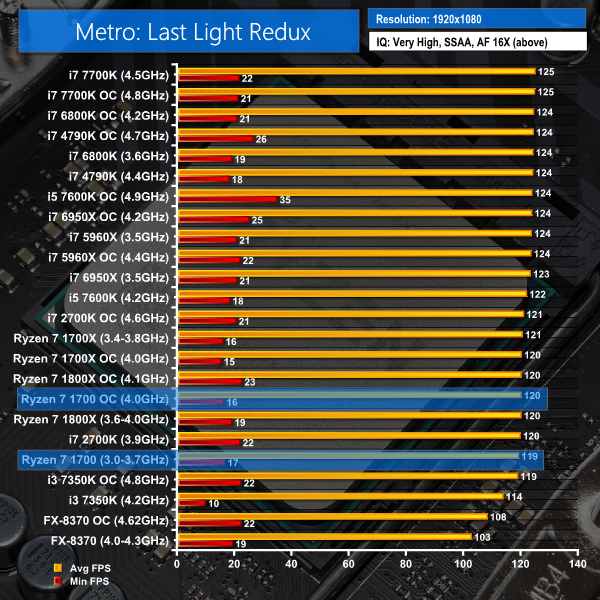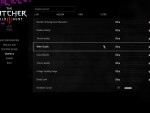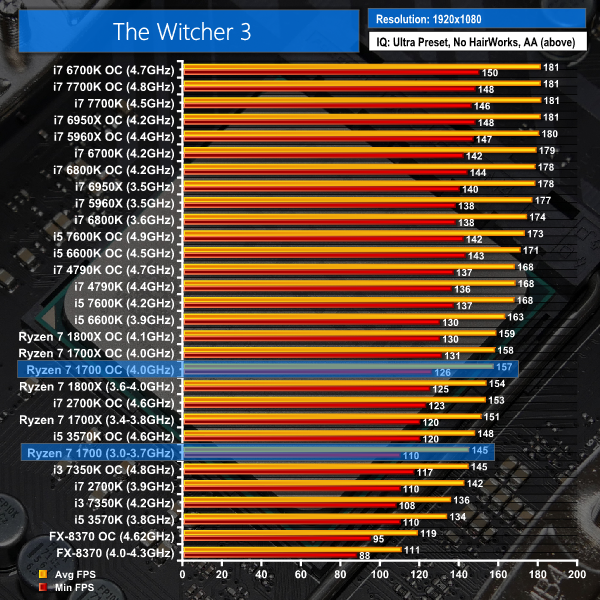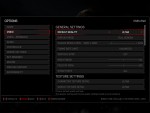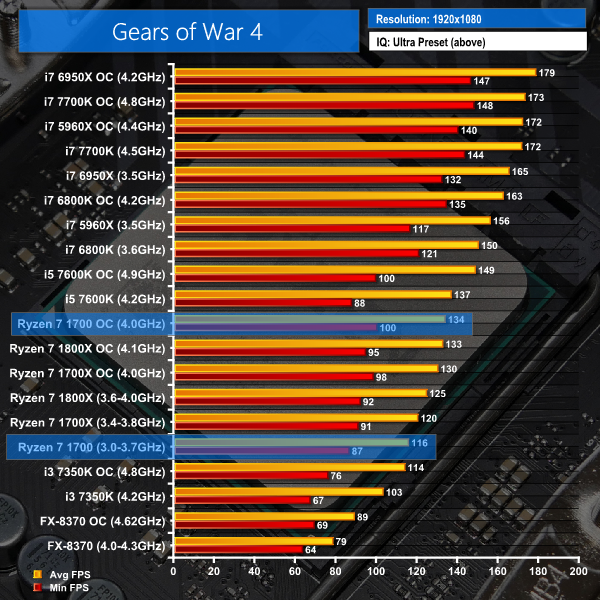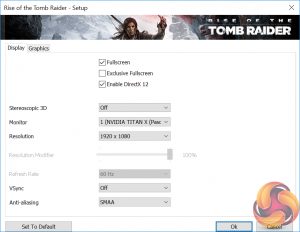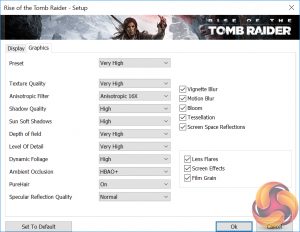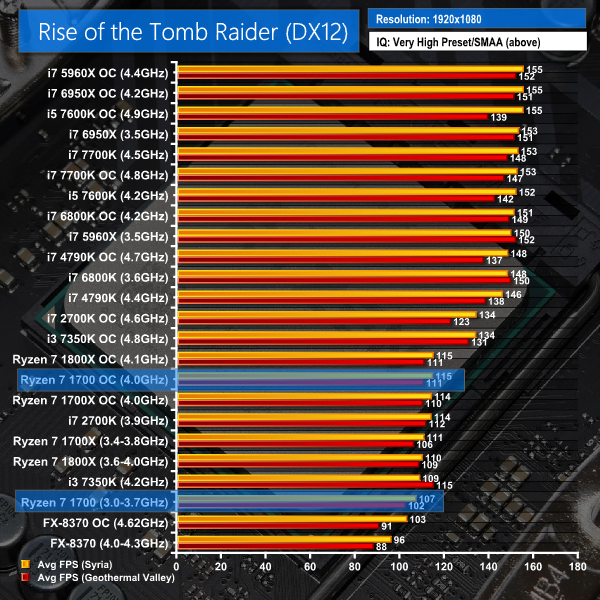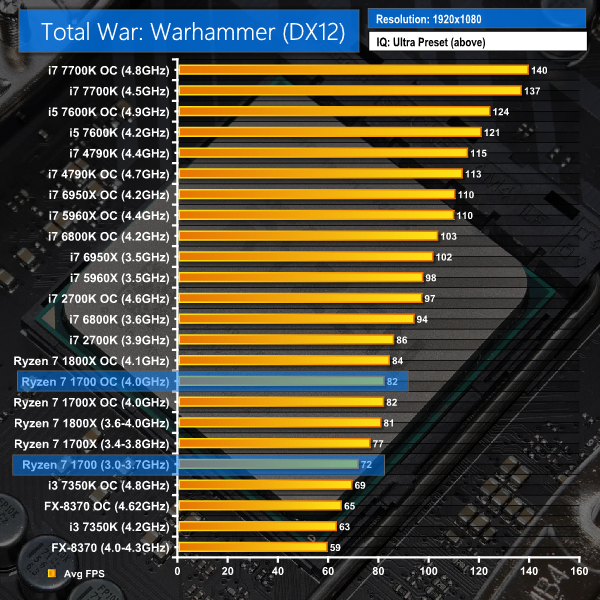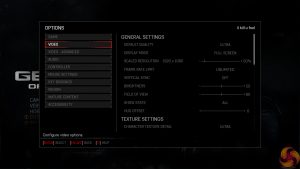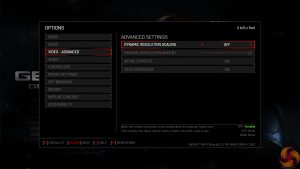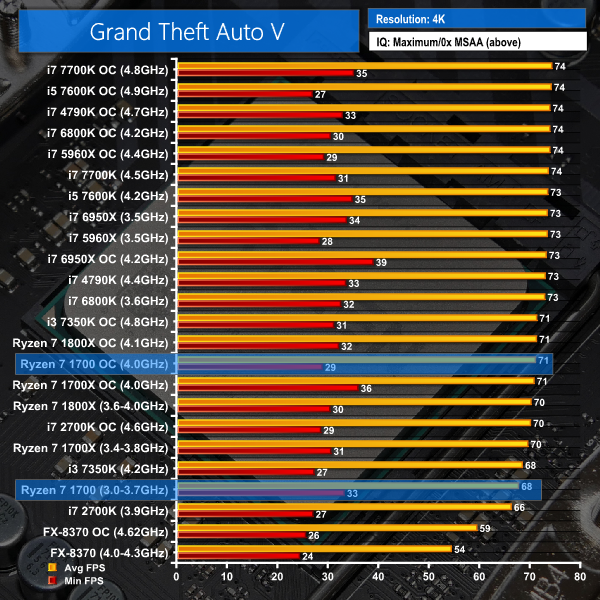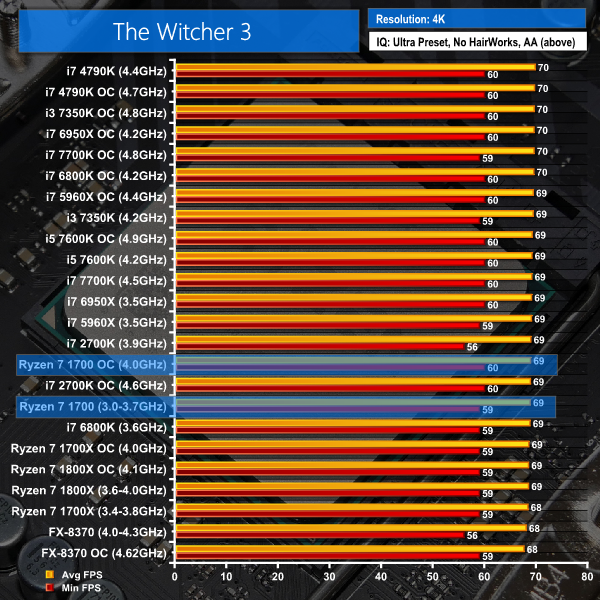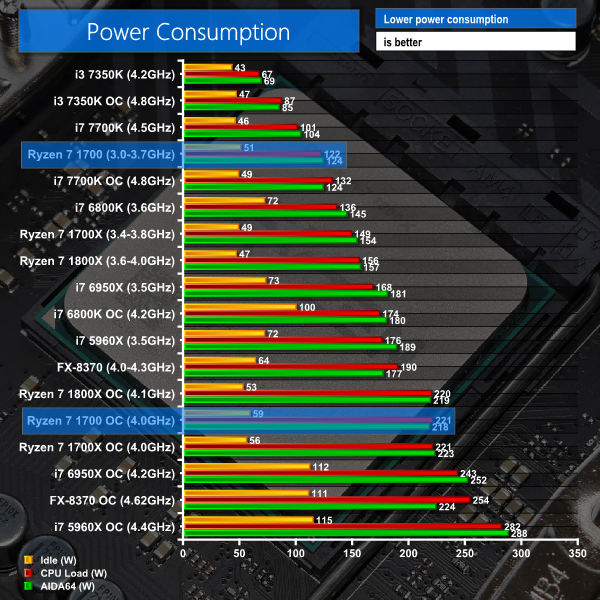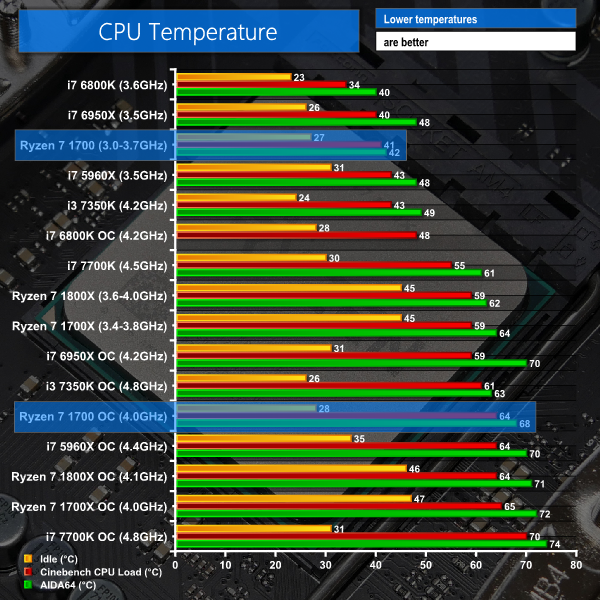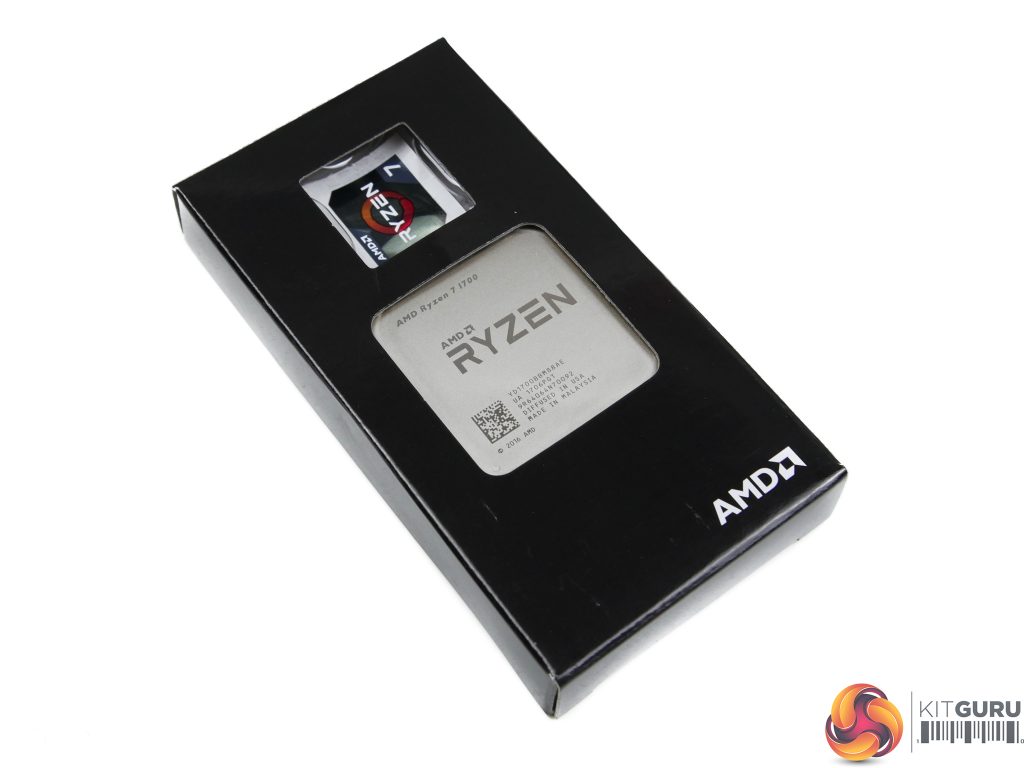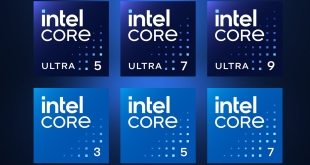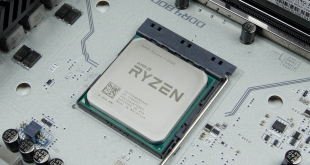
Ryzen 7 has already proven to be a worthy contender for Intel's LGA 2011-3 set of processors thanks to its similar, or sometimes better, performance levels and significantly cheaper cost. That metric is stretched even further with the 8C16T Ryzen 7 1700 that ships at just £330. At a relative bargain price compared to the higher-end Ryzen 7 SKUs, never mind Intel's £1000 octa-core part, Ryzen 7 1700 operates at a reduced clock speed out-of-the-box and is given a 65W TDP rating. You also get a decent Wraith Spire CPU cooler thrown into the bundle.
The most important point to enthusiasts is its retention of the unlocked CPU frequency multiplier that should allow a typical 1700 to reach 3.8-4.0GHz without much hassle. A £70-170 discount versus Ryzen 7 1700X and 1800X with the ability to hit similar top speeds certainly makes the 1700 chip an intriguing value proposition.
As we highlighted in our review of the 1700X, it is not uncommon for AMD to release multiple processor SKUs to market which are all essentially the same silicon. Binning is not an uncommon process in the computer hardware industry and it still remains an excellent method for enthusiasts to extract additional performance from a lower cost part.
For now, AMD's highest quality silicon forms the 1800X, with less-prime chips finding their home as 1700 and 1700X parts. There is a caveat to that logic, though, and that's the 1700's 65W TDP which will force it to use silicon that fits a different position on the voltage-frequency curve.
On the topic of that 65W TDP, we can already foresee the excitement of the 1700 to Small Form Factor (SFF) users once the AM4 mini-ITX motherboard situation improves. If you want to squeeze a high number of cores into a mini-ITX build, Ryzen 7 1700 looks to be an excellent method of doing so. That's also whilst avoiding the complexities of using LGA 2011-3 and 140W TDP Core i7 or Xeon CPUs in the same form factor. The ASRock X99E-ITX/ac is still an excellent work of engineering, nevertheless, which can single-handedly help Intel's HEDT platform in the SFF fight against Ryzen 7.
AMD's Ryzen 7 1700 comes bundled with a heatsink and fan, which is now unusual for £300+ CPUs since Intel removed the stock cooler from K SKUs with Skylake. The Wraith Spire cooler features a five-bladed, 92mm fan that forces air over an aluminium fin array fed by a copper slug in the core. The mounting mechanism now employs screws that fasten to an AM4 motherboard backplate, which is an upgrade over the relatively flimsy clip approach deployed with AMD's AM3 stock coolers.
Compared to an Intel stock cooler pulled from an old 4790K or modern multiplier-locked Core i5 or i7, it is easy to see the size advantage for the Wraith Spire. Also worth noting is the braided 4-pin fan cable that adds an element of quality. There's also an RGB LED ring on the top of the fan that can be controlled by the included 4-pin RGB adapter cable.
The Wraith Spire's mount on our AM4 ASUS Crosshair VI Hero was very solid and did not cause interference with neighbouring components. Removal of the plastic retention brackets is required as the cooler screws straight into the AM4 backplate. With the 4-pin RGB cable connected to our motherboard's header, the Wraith Spire cooler picked up the ASUS cyclic RGB profile without our adjustment and synchronised its operating mode and colours. Good job, AMD and ASUS.
Of course, being a cooler designed for use on AMD's PGA socket, you still get the old traditions of having to yank the CPU out of its socket when removing the cooler. This is largely due to the very sticky pre-applied thermal paste. It's something to watch out for if you decide to replace this cooler in the future as this is an easy way to damage the CPU.
| CPU | AMD Ryzen 7 1800X | AMD Ryzen 7 1700X | AMD Ryzen 7 1700 | Intel Core i7 6950X | Intel Core i7 6900K | Intel Core i7 6800K | Intel Core i7 7700K |
| CPU Codename | Zen | Zen | Zen | Broadwell-E | Broadwell-E | Broadwell-E | Kaby Lake |
| Core / Threads |
8 / 16 | 8 / 16 | 8 / 16 | 10 / 20 | 8 / 16 | 6 / 12 | 4 / 8 |
| Base Frequency | 3.6GHz | 3.4GHz | 3.0GHz | 3.0GHz | 3.2GHz | 3.4GHz | 4.2GHz |
| Boost Frequency | 4.0GHz | 3.8GHz | 3.7GHz | 3.5GHz | 3.7GHz | 3.6GHz | 4.5GHz |
| Maximum Frequency | 4.1GHz (XFR) | 3.9GHz (XFR) | 3.75GHz (XFR) | 4.0GHz (TBM 3.0) | 4.0GHz (TBM 3.0) | 3.8GHz (TBM 3.0) | n/a |
| Unlocked Core Multiplier | Yes (x0.25 granularity) | Yes (x0.25 granularity) | Yes (x0.25 granularity) | Yes (x1 granularity) | Yes (x1 granularity) | Yes (x1 granularity) | Yes (x1 granularity) |
| Total Cache | 16MB L3 + 4MB L2 | 16MB L3 + 4MB L2 | 16MB L3 + 4MB L2 | 25MB L3 + 2.5MB L2 | 20MB L3 + 2MB L2 | 15MB L3 + 1.5MB L2 | 8MB L3 + 1MB L2 |
| Max. Memory Channels |
2 (DDR4) | 2 (DDR4) | 2 (DDR4) | 4 (DDR4) | 4 (DDR4) | 4 (DDR4) | 2 (DDR4 & DDR3L) |
| Max. Memory Frequency |
1866 to 2667MHz | 1866 to 2667MHz | 1866 to 2667MHz | 2400MHz | 2400MHz | 2400MHz | 2400MHz / 1600MHz |
| PCIe Lanes | 16+4+4 | 16+4+4 | 16+4+4 | 40 | 40 | 28 | 16 |
| CPU Socket | AM4 | AM4 | AM4 | LGA 2011-3 | LGA 2011-3 | LGA 2011-3 | LGA 1151 |
| Manufacturing Process | 14nm | 14nm | 14nm | 14nm | 14nm | 14nm | 14nm |
| TDP | 95W | 95W | 65W | 140W | 140W | 140W | 91W |
| MSRP | $499 | $399 | $329 | $1723-1743 | $1089-1109 | $434-441 | $339-350 |
| UK Street Price | Approx. £500 | Approx. £400 | Approx. £330 | Approx. £1650 | Approx. £1000 | Approx. £400 | Approx. £330 |
Similarities between the entire Ryzen 7 line-up are vast. The 1700 retains the 8C16T design split over a pair of CPU Complexes (CCX) as is used for the 1700X and 1800X. 20MB of total cache is still available and the core frequency multiplier is unlocked to allow for easy overclocking.
The differences between the 1700 and other Ryzen 7 SKUs come in the form of out-of-the-box frequency, TDP, and XFR headroom. By default, the 1700 operates at a modest, due to the TDP target, 3.0GHz with a maximum Precision Boost clock speed of 3.7GHz. Highlighting the non-X difference of this SKU, XFR headroom is cut in half compared to the 1700X and 1800X, allowing the 1700 to operate at 50MHz above its maximum Precision Boost clock speed under the relevant conditions.
With sufficient cooling, you'll get a 3.2GHz all-core operating frequency out-of-the-box, 3.7GHz maximum multi-core Precision Boost operating speed, and 3.75GHz XFR frequency for single-core operations. Of course, that's before playing with the core ratio multiplier that can give 25MHz granularity for CPU speed increases.
For more information regarding Ryzen 7 and the AM4 platform, read our launch review for the Ryzen 7 1800X HERE. You can also read our Ryzen 7 1700X review HERE.
Overclocking the Ryzen 7 1700 was a practically identical procedure to that of the 1700X and the 1800X. The main settings worth tweaking for CPU overclocking are the CPU VCore, loadline calibration, and SOC voltage to aid stability especially with higher-speed memory kits. If your motherboard has the option in its UEFI (which ASUS' C6H does not), bumping NB voltage up to around 1.10-1.15V can aid stability.
Default voltage for manual tuning should start at around 1.3625V, according to AMD. Users should be fine pushing to 1.40V with a decent CPU cooler and up to 1.45V with a high-end dual-tower heatsink or dual-fan AIO radiator. At 1.45V, however, AMD suggests that processor longevity could be affected according to their models.
We used the same overclocking procedure for our Ryzen 7 1700 chip as we did for the 1700X. That meant applying a 1.41875V VCore in the ASUS UEFI with Level 2 LLC (to get close to 1.4V under load). With this configuration, load voltage hovered around 1.395-1.417V and idle voltage was higher due to a low current flowing through the CPU.
SOC voltage was set to 1.25V and our memory was maintained at 3200MHz 14-14-14-34 with 1.35V.
In short, our final Ryzen 7 1700 overclocking settings using an ASUS Crosshair VI Hero motherboard were:
- 1.41875V CPU VCore.
- 1.25V SOC voltage.
- Level 2 LLC (around 1.395-1.417V load VCore in OS).
- Multiple Cinebench R15 multi-core runs to validate stability, as well as AIDA64 CPU stress test.
- DDR4-3200MHz 14-14-14-34 @ 1.35V.
AMD Ryzen 7 1700 Overclocking – 4.0GHz Stable
Our Ryzen 7 1700 chip at 4.0GHz with a load voltage between 1.395-1.417V was stable through Cinebench, Handbrake, and a short run of Prime 95. We would be happy running at these levels for 24/7 usage with our particular silicon. We didn't test with lower voltage levels as this result was perfectly stable on our chip and temperatures did not get out of hand with the Noctua NH-D15 cooler.
We have seen reports of 1700 CPUs generally hitting around 3.8-4.0GHz with sensible voltage levels and our results would add to those suggestions. A stable overclock matching that of our 1700X sample is a very impressive result for the 1700. Though there are no guarantees with the silicon lottery, our results mapped into the real world basically translates into a £70 saving versus the 1700X and a free CPU cooler. That's a good deal for enthusiasts who are willing to spend a few minutes tweaking within the UEFI and a few hours to validate stability.
The chip may have pushed a little higher with SMT or cores disabled but we didn't try any of that. We preferred 4.0GHz with all eight cores and SMT enabled and a sensible 24/7 voltage level.
High-speed Memory Support
We were able to use 3200MHz dual-channel DDR4 (2 single-sided DIMMs) with the Ryzen 7 1700 while at stock clocks and when overclocked to 4.0GHz. This was the case using the ASUS Crosshair VI Hero motherboard.
The less-prime silicon forming our 1700 did not seem to have a profound influence on IMC strength, up to our tested level of 3.2GHz CL14, that is.
There are still some early BIOS and platform bugs with the AM4 platform and high-speed memory. However, our G.Skill Trident Z 2x8GB 3200MHz has worked fine with four different Ryzen 7 CPUs, even if the ASUS motherboard can be a little temperamental from a cold boot. We found that booting from cold using 2933MHz and then restarting the system to apply 3200MHz can solve any cold boot high-speed memory issues.
We will be outlining the Ryzen 7 1700 CPU's performance while using an ASUS Crosshair VI Hero AM4 motherboard.
A 16GB (2x8GB) kit of G.Skill's Trident Z DDR4 memory serves our test system. The kit's rated frequency of 3200MHz with CL14 timings should ensure that memory-induced bottlenecks are removed. A strength for the ASUS board is its ability to run this memory at 3200MHz CL14, which is pushing on the limit of memory speed capability for the AM4 platform.
Today's comparison processors come in the form of:
- Piledriver FX-8370.
- Sandy Bridge i7-2700K.
- Ivy Bridge i5-3570K.
- Devil's Canyon i7-4790K (Haswell-based).
- Haswell-E i7-5960X.
- Broadwell-E i7-6800K and i7-6950X.
- Skylake's i5-6600K and i7-6700K.
- Kaby Lake's i3-7350K, i5-7600K, and i7-7700K.
- Ryzen 7 1700X and 1800X.
These form some of the best and most popular CPUs in their respective pricing ranges and product hierarchies for this generation and past ones. They also give a solid overview of where the Ryzen 7 1700X slots into the current market in terms of performance.
We went out and paid over £1,500 (!) to buy a Core i7-6950X 10C20T CPU in order to compare Ryzen 7 offerings to the current fastest consumer processor on the market. Our trusty old Haswell-E Core i7-5960X serves as the 8C16T competitor for Intel's HEDT platform as we do not have access to the Broadwell-E i7-6900K (which is very similar in performance).
The Ryzen 7 1700 sat comfortably at its 3.2GHz all-core boost frequency throughout testing thanks to our strong Noctua D15 CPU cooler and solid power delivery from the ASUS motherboard. XFR was confirmed as operating at 3.75GHz by running multiple different single-threaded workloads and checking the real-time clock speed.
We test Intel CPUs using the forced turbo (multi-core turbo – MCT) setting that most motherboard vendors now enable by default or when using XMP memory. This feature pins all of the CPU's cores at the maximum turbo boost frequency all of the time. The voltage is bumped up to enhance stability but this results in greater power consumption and higher temperature readings which are important to remember when testing those parameters.
We also tested all CPUs' achievable overclocked frequencies so that you can see how your overclocked chip compares to another stock or overclocked chip.
CPU Test System Common Components:
- Graphics Card: Nvidia GeForce GTX Titan X Pascal (custom fan curve to eliminate thermal throttling).
- CPU Cooler: Noctua NH-D14 / Noctua NH-D15 / Cryorig R1 Ultimate / Corsair H100i v2 / Corsair H110i GT / EKWB Predator 240.
- Games SSD: SK hynix SE3010 SATA 6Gbps 960GB.
- Power Supply: Seasonic Platinum 1000W / Seasonic Platinum 760W.
- Operating System: Windows 10 Pro 64-bit (Anniversary Update).
We use a mixture of high-end air and AIO coolers to gather performance measurements without thermal throttling playing a part. Seasonic's Platinum-rated PSUs provide ample power to really push the CPU overclocks. Nvidia's GTX Titan X Pascal is the fastest gaming GPU on the planet, making it ideal for alleviating GPU-induced bottlenecks and putting the onus on CPU performance.
While we use a mixture of cooling and PSU hardware for general testing, where it is important to keep those items identical (power draw and temperature readings) we ensure that the correct hardware is used to deliver accurate data.
Ryzen AM4 System (Ryzen 7 1800X, Ryzen 7 1700X):
- 1800X CPU: AMD Ryzen 7 1800X ‘Summit Ridge' 8 cores, 16 threads (3.6-4.0GHz stock w/ 4.1GHz XFR & 4.1GHz @ 1.43125V overclocked).
- 1700X CPU: AMD Ryzen 7 1700X ‘Summit Ridge' 8 cores, 16 threads (3.4-3.8GHz stock w/ 3.9GHz XFR & 4.0GHz @ 1.41875V overclocked).
- 1700 CPU: AMD Ryzen 7 1700 ‘Summit Ridge' 8 cores, 16 threads (3.0-3.7GHz stock w/ 3.75GHz XFR & 4.0GHz @ 1.41875V overclocked).
- Motherboard: ASUS Crosshair VI Hero (AM4, X370).
- Memory: 16GB (2x8GB) G.Skill Trident Z 3200MHz 14-14-14-34 DDR4 @ 1.35V.
- System Drive: Crucial MX300 525GB.
Kaby Lake & Skylake LGA 1151 System (7600K, 7700K, 6600K, 6700K):
- 7600K CPU: Intel Core i5-7600K ‘Skylake' (Retail) 4 cores, 4 threads (4.2GHz stock MCT & 4.9GHz @ 1.35V overclocked).
- 7700K CPU: Intel Core i7-7700K ‘Skylake' (Retail) 4 cores, 8 threads (4.5GHz stock MCT & 4.8GHz @ 1.35V overclocked).
- 6600K CPU: Intel Core i5-6600K ‘Skylake' (Retail) 4 cores, 4 threads (3.9GHz stock MCT & 4.5GHz @ 1.35V overclocked).
- 6700K CPU: Intel Core i7-6700K ‘Skylake' (Retail) 4 cores, 8 threads (4.2GHz stock MCT & 4.7GHz @ 1.375V overclocked).
- Motherboard: MSI Z270 Gaming Pro Carbon & Gigabyte Aorus Z270X-Gaming 7 (LGA 1151, Z270).
- Memory: 16GB (2x8GB) G.Skill Trident Z 3200MHz 14-14-14-34 DDR4 @ 1.35V.
- System Drive: Samsung 840 500GB.
Broadwell-E & Haswell-E LGA 2011-3 System (5960X, 6800K, 6950X):
- 5960X CPU: Intel Core i7 5960X ‘Haswell-E' (Engineering Sample) 8 cores, 16 threads (3.5GHz stock MCT & 4.4GHz @ 1.30V overclocked).
- 6800K CPU: Intel Core i7 6800K ‘Broadwell-E' (Retail) 6 cores, 12 threads (3.6GHz stock MCT & 4.2GHz @ 1.275V overclocked).
- 6950X CPU: Intel Core i7 6950X ‘Broadwell-E' (Retail) 10 cores, 20 threads (3.5GHz stock MCT & 4.2GHz @ 1.275V overclocked).
- Motherboard: ASUS X99-Deluxe (LGA 2011-v3, X99).
- Memory: 32GB (4x8GB) G.Skill Trident Z 3200MHz 14-14-14-34 DDR4 @ 1.35V.
- System Drive: SanDisk Ultra Plus 256GB.
Devil's Canyon LGA 1150 System (4790K):
- 4790K CPU: Intel Core i7 4790K ‘Devil's Canyon' (Engineering Sample) 4 cores, 8 threads (4.4GHz stock MCT & 4.7GHz @ 1.30V overclocked).
- Motherboard: ASRock Z97 OC Formula (LGA 1150, Z97).
- Memory: 16GB (2x8GB) G.Skill Trident X 2400MHz 10-12-12-31 DDR3 @ 1.65V.
- System Drive: Kingston SM2280S3/120G 120GB.
Sandy Bridge & Ivy Bridge LGA 1155 System (2700K, 3570K):
- 2700K CPU: Intel Core i7 2700K ‘Sandy Bridge‘ (Retail) 4 cores, 8 threads (3.9GHz stock MCT & 4.6GHz @ 1.325V overclocked).
- 3570K CPU: Intel Core i5 3570K ‘Ivy Bridge' (Retail) 4 cores, 4 threads (3.8GHz stock MCT & 4.6GHz @ 1.30V overclocked).
- Motherboard: ASUS P8Z77-V (LGA 1155, Z77).
- Memory: 16GB (2x8GB) G.Skill Trident X 2400MHz 10-12-12-31 DDR3 @ 1.65V (@2133MHz for 2700K due to CPU IMC limitation).
- System Drive: Kingston HyperX 3K 120GB.
Vishera AM3+ System (FX-8370):
- FX-8370 CPU: AMD FX-8370 ‘Vishera' (Retail) 8 cores, 8 threads (4.0-4.3GHz stock & 4.62GHz @ 1.45V CPU, 2.6GHz @ 1.30V NB overclocked).
- Motherboard: Gigabyte 990FX-Gaming (AM3+, SB950).
- Memory: 16GB (2x8GB) G.Skill Trident X 2133MHz 12-12-12-31 DDR3 @ 1.65V.
- System Drive: Patriot Wildfire 240GB.
Software:
- ASUS Crosshair VI Hero BIOS v5704 (pre-release).
- GeForce 378.49 VGA drivers.
Tests:
Productivity-related:
- Cinebench R15 – All-core & single-core CPU benchmark (CPU)
- HandBrake 0.10.5 – Convert 6.27GB 4K video recording using the Normal Profile setting and MP4 container (CPU)
- Mozilla Kraken – Browser-based JavaScript benchmark (CPU)
- x265 Benchmark – 1080p H.265/HEVC encoding benchmark (CPU)
- WPrime – 1024M test, thread count set to the CPU's maximum number (CPU)
- SiSoft Sandra 2016 SP1 – Processor arithmetic, cryptography, and memory bandwidth (CPU & Memory)
- 7-Zip 16.04 – Built-in 7-Zip benchmark test (CPU & Memory)
Gaming-related:
- 3DMark Fire Strike v1.1 – Fire Strike (1080p) test (Gaming)
- 3DMark Time Spy – Time Spy (DX12) test (Gaming)
- VRMark – Orange room (2264×1348) test (Gaming)
- Ashes of the Singularity – Built-in benchmark tool CPU-Focused test, 1920 x 1080, Extreme quality preset, DX12 version (Gaming)
- Gears of War 4 – Built-in benchmark tool, 1920 x 1080, Ultra quality preset, Async Compute Enabled, DX12 (Gaming)
- Grand Theft Auto V – Built-in benchmark tool, 1920 x 1080, Maximum quality settings, Maximum Advanced Graphics, DX11 (Gaming)
- Metro: Last Light Redux – Built-in benchmark tool, 1920 x 1080, Very High quality settings, SSAA Enabled, AF 16X, High Tessellation, DX11 (Gaming)
- Rise of the Tomb Raider – Built-in benchmark tool, 1920 x 1080, Very High quality preset, SMAA enabled, DX12 version (Gaming)
- The Witcher 3: Wild Hunt – Custom benchmark run in a heavily populated town area, 1920 x 1080, Maximum quality settings, Nvidia features disabled, DX11 (Gaming)
- Total War Warhammer – Built-in benchmark tool, 1920 x 1080, Ultra quality preset, DX12 version (Gaming)
Cinebench
Cinebench is an application which renders a photorealistic 3D scene to benchmark a computer’s rendering performance, on one CPU core, all CPU cores or using the GPU. We run the test using the all-core CPU and single-thread CPU modes.
Handbrake Conversion
Handbrake is a free and open-source video transcoding tool that can be used to convert video files between different codecs, formats and resolutions. We measured the average frame rate achieved for a task of converting a 6.27GB 4K video using the Normal Profile setting and MP4 container. The test stresses all CPU cores to 100% and shows an affinity for memory bandwidth.
x265 Encoding
x265 Encoding tests system performance by encoding a 1080p test file using the x265/HEVC format.
CPU-related testing overview:
Ryzen 7 1700, just like its bigger brothers, proves itself to be a solid option for multi-threaded workloads. The £330 CPU offers performance that is competitive against Intel's £1000 Core i7-5960X from yesteryear. That point is especially true when overclocking is added into the equation for both sides. The overclocked 1700 outperforming an overclocked 5960X chip that is three times its price in Cinebench is impossible to criticise.
A similarly-priced Core i7-7700K is comfortably outperformed in multi-threaded workloads by the Ryzen 7 1700. Stock versus stock, the 1700 is 45% faster than the 7700K in Cinebench multi-threaded and 69% faster when both CPUs are overclocked. The 1700's lead in Handbrake is 24% at stock and 37% with both processors overclocked. X265 encoding shows a similar trend.
Where Ryzen 7 1700 does not perform so well against Intel is the Cinebench single-threaded task. A 3.75GHz XFR clock salvages a respectable score around the 5960X level but once overclocking is factored in, the 1700 trails Haswell-E, Broadwell-E, and Skylake single-threaded performance largely due to its frequency deficit. If single-threaded performance is important to you, the Core i7-7700K at its forced-turbo speed is 37% faster than Ryzen 7 1700. That advantage still sits at a sizeable 26% with both processors overclocked.
The short summary for these tests is that Ryzen 7 1700 can hang with Intel HEDT chips three times its price in multi-threaded workloads, especially when overclocked. The similarly-priced Core i7-7700K is completely outclassed by Ryzen 7 1700 when you can leverage its sixteen threads. However, single-threaded performance is better on Intel's modern parts, especially when overclocked due to their higher frequency capabilities.
7-Zip
7-Zip is an open source Windows utility for manipulating archives. We measure the Total Rating performance using the built-in benchmark tool. The test stresses all CPU cores to 100% and shows an affinity for memory bandwidth.
Mozilla Kraken
Mozilla Kraken is a browser-based JavaScript benchmark that tests a variety of real-world use cases. We use Chrome as the test browser. The test exhibits very little multi-threading and shows an affinity for CPU clock speed and IPC.
WPrime
WPrime is a leading multithreaded benchmark for x86 processors that tests your processor performance by calculating square roots with a recursive call of Newton’s method for estimating functions. We use the 1024M test in WPrime to analyse processor calculation performance.
CPU-related testing overview:
7-Zip likes cores and memory bandwidth so Ryzen 7 1700 paired with fast DDR4 takes a comfortable position behind the Intel HEDT 8+ core chips. Even with the 7700K overclocked to 4.8GHz, stock-clocked Ryzen 7 1700 enjoys a 21% performance lead that extends to 43% with the AMD chip at 4.0GHz.
Kraken is largely single-threaded so the stock-clocked score for Ryzen 7 1700 sits around 5960X and 6950X levels due to the frequency limitations. At 4.0GHz, Ryzen 7 1700 shows a solid improvement and is able to offer slightly better performance than overclocked Core i7-5960X and 6950X competitors. Compared to the Kaby Lake 7700K and its superior architecture and higher clock speed, however, Ryzen 7 1700 takes a comfortable beating at both stock (40% slower versus stock 7700K) and overclocked (23% slower versus OC 7700K) speeds.
WPrime takes advantage of the 1700's sixteen threads for number crunching and returns stellar performance. The £330 chip comfortably holds its own against Intel's £1000 octa-core and the similarly-priced 4C8T 7700K is noticeably slower than Ryzen 7 1700, even with a 1GHz+ frequency advantage.
Sandra Processor Arithmetic
Sandra Cryptographic
Sandra Memory Bandwidth
Synthetic performance also shines the 1700 under a positive light. You can extract most of the performance offered by Intel multi-core parts that are significantly more expensive. That's particularly true when overclocking the 1700 to 4GHz, at which point there is no distinguishable difference between it and the £70 more expensive 1700X. Intel's quad-core 7700K is comfortably beaten in Sandra's Arithmetic and Cryptographic tests.
Memory bandwidth is an advantage for LGA 2011-3 CPUs thanks to their quad-channel capability. This is also shown in tests such as 7-Zip and Handbrake which have an affinity for memory bandwidth.
3DMark
3DMark is a multi-platform hardware benchmark designed to test varying resolutions and detail levels of 3D gaming performance. We run the Windows platform test and in particular the Fire Strike benchmark, which is indicative of high-end 1080p PC Gaming. We also test using the Time Spy benchmark which gives an indication of DirectX 12 performance.
VRMark
The recently-released VRMark benchmark aims to score systems based on their VR performance potential by using rendering resolutions associated with VR devices of today and the future. We test using the Orange Room benchmark which uses a rendering resolution of 2264×1348 to analyse the capability of hardware with current devices such as the HTC Vive and Oculus Rift.
The 1700 continues to post impressive performance results in the multi-threaded 3DMark Fire Strike and Time Spy tests. VRMark is less favourable for the 1700 and clearly prefers the architecture and generally higher clock speeds of Intel's competitors such as the 7700K.
Grand Theft Auto V
Grand Theft Auto V remains an immensely popular game for PC gamers and as such retains its place in our test suite. The well-designed game engine is capable of providing heavy stress to a number of system components, including the GPU, CPU, and Memory, and can highlight performance differences between motherboards.
We run the built-in benchmark using a 1080p resolution and generally Maximum quality settings (including Advanced Graphics).
Metro: Last Light Redux
Despite its age, Metro: Last Light Redux remains a punishing title for modern computer hardware. We use the game's built-in benchmark with quality set to Very High, SSAA enabled, AF 16X, and High tessellation.
The Witcher 3: Wild Hunt
The Witcher 3 is a free-roaming game which can feature heavy interaction from NPCs in densely-populated urban areas, making it ideal for testing CPU performance. The well-designed game engine is capable of providing heavy stress to a number of system components and will happily use more than four CPU threads when such hardware is available.
We run a custom benchmark which is located in a heavily populated section of an urban town area. A 1080p resolution and Maximum quality settings are used (Nvidia Hairworks settings are disabled).
Gaming performance from Ryzen 7 has been given a lot of coverage by now, so it is somewhat of a known entity. The 1700 continues to show unimpressive gaming performance to those who are interested in high-refresh rates and frame rates above 60 FPS. Intel's Core i7-7700K is still king when it comes to DX11 gaming thanks to its well-tuned Skylake architecture and high clock frequencies.
If you are spending around £330 on a CPU purely for gaming, the Core i7-7700K is a better choice than Ryzen 7 1700. AMD has suggested that updates and patches will come from game developers, and there's also a slim improvement to performance when disabling SMT, but that doesn't deter from the point that the 7700K is a faster gaming chip in today's environment.
Of course, if you play any of these games on a 60Hz monitor (or even a <120Hz monitor for the last two), you are unlikely to notice any difference in performance between the Ryzen 1700 and Core i7-7700K. That point can also be extended to cheaper Core i5 CPUs.
Ashes of the Singularity
Ashes of the Singularity is a Sci-Fi real-time strategy game built for the PC platform. The game includes a built-in benchmark tool and was one of the first available DirectX 12 benchmarks. We run the CPU-focused benchmark using DirectX 12, a 1080p resolution and the Extreme quality preset.
Gears of War 4
Gears of War 4 is a third-person shooter available on Xbox One and in the form of a well-optimised DX12-only PC port. We run the built-in benchmark using DirectX 12 (the only API supported), a 1080p resolution, the Ultra quality preset, and Async Compute enabled.
Note: The Core i7-2700K, i5-3570K, and i7-4790K are not shown in Gears of War 4 as the game download was too large to install on their system SSD and the clunky Windows Store platform gives errors when moving games installed on a secondary SSD between test systems.
Rise of The Tomb Raider
Rise of The Tomb Raider is a popular title which features both DX11 and DX12 modes. Heavy loading can be placed on the CPU, especially in the Syria and Geothermal Valley sections of the built-in benchmark.
We run the built-in benchmark using the DirectX 12 mode, a 1080p resolution, the Very High quality preset, and SMAA enabled.
Total War: Warhammer
Total War: Warhammer is another title which features both DX11 and DX12 modes. Heavy loading can be placed on the CPU using the built-in benchmark. The DX12 mode is poorly optimised and tries to force data through a low number of CPU threads rather than balance operations across multiple cores. As such, this gives a good look at pure gaming performance of each CPU in titles that aren't well multi-threaded.
We run the built-in benchmark using the DirectX 12 mode, a 1080p resolution, and the Ultra quality preset.
Despite AMD confirming that there is no issue with the Windows 10 Scheduler, DX12 gaming performance for Ryzen 7 1700 is lower than on competing Core i7 CPUs and even the Kaby Lake Core i5-7600K in some scenarios.
The same is still true, though; if you game at 60Hz, Ryzen 7 1700 performance will be similar to Intel's Kaby Lake Core i5 and Core i7 offerings, as well as other high-end Intel processors. However, switching focus to high refresh-rate gaming, Ryzen 7 1700 shows weaknesses when targetting 120+ FPS in Rise of The Tomb Raider and Gears of War 4, and cannot manage 100 FPS in Total War: Warhammer, even when overclocked.
For high refresh-rate gaming with DX12 titles, the Core i7-7700K is a better choice than Ryzen 7 1700 at £330. Of course, developers may better utilise the additional threads of Ryzen 7 in the future, and there is also a higher proportion of the CPU horsepower in reserve for multi-tasking whilst also gaming (compared to the 7700K). As it stands, though, Kaby Lake's i7-7700K is faster for gaming and that's visible at more than 60 FPS.
The market for people buying an expensive CPU and using it for gaming at 1080p is likely to be very slim. What 1080p does is give a good indication of the CPU's raw gaming performance as GPU power is sufficient to push frame rates to a level where the CPU and memory limitations can be observed.
We supplement the 1080p gaming results with a trio of games tested at 4K. That multiple-hundred pound saving against Intel's competing 8C16T CPU could buy a nice 4K monitor, so we will show how Ryzen 7 performs at such a resolution.
Gears of War 4
We run the built-in benchmark using a 4K resolution and the same settings as the 1080p test (Ultra quality preset, Async Compute enabled).
Note: The Core i7-2700K and i7-4790K are not shown in Gears of War 4 as the game download was too large to install on their system SSD and the clunky Windows Store platform gives errors when moving games installed on a secondary SSD between test systems.
Grand Theft Auto V
We run the built-in benchmark using a 4K resolution and the same settings as the 1080p test (generally Maximum quality settings including Advanced Graphics).
The Witcher 3 Wild Hunt
We run our custom 107-second benchmark in a densely-populated town area using a 4K resolution and the same settings as the 1080p test (Maximum quality, Nvidia settings disabled).
At 4K, where graphics horsepower is taxed and pushed to the forefront, Ryzen 7 1700 offers effectively the same performance as other modern Intel CPUs, including the i7-7700K. Grand Theft Auto V and its preference for Intel processors shows a slight performance deficit for Ryzen 7 at 4K but the around 2 FPS drop in average frame rates is minor.
If you are a 4K60 gamer who wants to leverage Ryzen 7, performance will be as good as Intel's fastest gaming CPUs due to such emphasis being put on GPU performance. This picture may change when 4K 100Hz+ monitors and more powerful graphics cards become available but on the contrary, new games may also be better optimised for the Ryzen 7 processors by that point in time.
We leave the system to idle on the Windows 10 desktop for 5 minutes before taking a power draw reading. For CPU load results we read the power draw while running the Cinebench multi-threaded test as we have found it to push power draw and temperature levels beyond those of AIDA 64 and close to Prime 95 levels. Cinebench has a short run time on high-performance CPUs which influences the validity of the temperature reading, so we run AIDA64 stress test to validate data.
The power consumption of our entire test system (at the wall) is shown in the chart.
The same test parameters were used for temperature readings.
Power Consumption
Power draw readings are accurate to around +/- 5W due to fluctuations in the value even at sustained load. We use a Platinum-rated Seasonic 760W PSU and install a GTX 1070 video card that uses very little power.
Power consumption from the stock-clocked Ryzen 7 1700 is superb thanks to its voltage being reined in to hit the 65W TDP target. All of the Intel HEDT chips that we tested drew more power under load than the Ryzen 7 1700, despite being outperformed by AMD's part in many scenarios. Compared to the other Ryzen 7 SKUs, the 1700's 30W reduction in TDP translates closely into the power draw decrease observed.
A quick Cinebench-point-per-Watt calculation scores the Ryzen 7 1700 (stock) at 11.7 points-per-Watt, with the Core i7-7700K scoring 9.7 points-per-Watt at its stock (forced-turbo) frequency. The Core i7-6800K manages 8.4 points-per-Watt, the 6950X is at 11.0 points-per-Watt, and Ryzen 7 1800X sits at 10.4 points-per-Watt. Put simply, the Ryzen 7 1700 processor's performance-per-Watt is absolutely superb. That's an important metric for many prosumers who pay for electricity or users who want to squeeze a high-performance CPU into a SFF chassis with limited thermal budget.
Overclocked using the same voltage as the Ryzen 7 1700X, Ryzen 7 1700 draws practically the same power.
Temperatures
Temperature recordings were taken using the Noctua NH-D14 for the LGA 1151 test system, Cryorig R1 Ultimate for the LGA 2011-3 system, and Noctua NH-D15 for the AM4 system. We use different coolers for speed purposes. Each CPU cooler's fans were running at full speed. Ambient temperature was maintained at around 20°C.
Due to the use of slightly different CPU coolers, our temperature measurements should only be used as a guideline. Performance differences below around 3°C are small enough to say that cooling results were similar.
Update 17/03/2017: AMD has announced that Ryzen 7 1800X and 1700X have a +20°C temperature offset on the reading currently displayed by software, over the actual junction temperature. AMD is advising that 20°C can be subtracted from the reported Ryzen 7 1800X and 1700X temperature values to understand the actual junction temperature. The Ryzen 7 1700 does not have a temperature offset so its reported values are the actual junction temperature values, according to AMD. However, the reported temperature reading with the Ryzen 7 1700 overclocked brings into question the operation of AMD's temperature sensor and/or offset value for the Ryzen 7 1700 (which should be operating around 20°C lower than reported, similar to 1700X and 1800X levels, if it has no offset reporting coded in).
Thanks to its low power draw and superb heatspreader design, which uses solder and a liquid-metal TIM, Ryzen 7 1700 shows excellent temperature performance at stock. There have been suggestions that AMD's temperature-reading sensor is inaccurate, which has an influence on our analysis. However, limiting the comparison to other Ryzen 7 chips, the 1700 still shows excellent thermal performance.
When overclocked using a load voltage of 1.395-1.417V, our Ryzen 7 1700 sample operated similarly to the 1700X. Variations this small are too close to declare anything other than tied performance between the pair. Assuming that the mid-to-high-60s temperature reading for Ryzen 7 1700 is accurate, based on AMD's sensor design, I would have no worries about operating under these temperature levels for extended usage periods.
We did a quick batch of testing with AMD's included Wraith Spire RGB cooler and found it to be a decent unit. At the stock voltage, which drops to around 1.09V on our chip under load, Wraith Spire comfortably kept our CPU cool at full fan speed (around 2700 RPM). The 1700 operated at 32°C idle, 49°C under Cinebench multi-threaded load, and that increased to just shy of 60°C after five minutes of AIDA64 CPU stress test.
We applied an overclock to 3.7GHz which used a core voltage of 1.373V under heavy load. This was a little too far for the Wraith Spire as it ran at 33°C idle, 70°C Cinebench load, and 94°C after five minutes of AIDA64 CPU stress test. 94°C is too high, even for a stress test, so we would recommend backing down to less than 1.36V if you plan to use this cooler for short loading periods or less than 1.35V (perhaps lower depending on your case cooling) for sustained heavy load.
Even at around 2700 RPM, the cooler was far from obtrusively loud. It was certainly audible but didn't strike me as annoying, especially compared to something like a 240mm AIO under any type of heavy load. The top-down design also has the benefit of providing some airflow to the nearby VRM components on a motherboard.
AMD's Ryzen 7 1700 is perhaps the most interesting chip in the line-up due to its lower price than the 1700X and 1800X, which were superb value in their own right. A new level of multi-threaded performance has been delivered at a £330 price point where Intel can only currently offer a hyper-threaded quad-core processor as its competing option.
Needless to say, the 8C16T Ryzen 7 1700 handsomely outperforms the 4C8T Core i7-7700K in multi-threaded workloads such as video encoding and rendering. The AMD part also offers significantly higher performance-per-Watt than the i7-7700K in those same multi-threaded prosumer workloads and it does so while having a 65W TDP that delivers less stringent CPU cooler requirements. It even includes the Wraith Spire CPU cooler that features an RGB LED strip.
Once overclocking is added into the equation, the Ryzen 7 1700 offers most of the performance of the higher-priced Ryzen 7 parts and is able to outperform an Intel 8C16T Core i7 that is three times its price in a number of tests. If you are willing to allocate a few minutes to tinkering in the UEFI and a few hours to validate stability, the Ryzen 7 1700 can reward you with overclocking results that deliver a solid increase in performance.
Gaming performance is still the same as other Ryzen 7 parts. If you have either the graphics horsepower or a low enough resolution to drive very high frame rates, Intel's Core i7 CPUs, especially the Kaby Lake 7700K, are better performers. However, if you game on a 60Hz monitor or have a graphics solution that means you'll be hitting a GPU bottleneck point before the CPU's, Ryzen 7 1700 holds its own in games.
There are also promises of updates and game patches being outlined by AMD, as well as the likelihood of developers better utilising the Ryzen 7 CPUs' performance in future titles, but we cannot analyse future ‘suggested‘ performance. The point is, however, valid as potential performance improvements in future months and years should be considered when making the decision for which processor you want to buy. Ryzen 7 1700's multi-threaded performance would suggest that it has more to offer in gaming scenarios. With that said, games are not always best designed for scaling with thread count rather than clock speed or architectural performance (where Intel holds the advantage).
If you are a prosumer who has multiple workloads and want a balanced computer, that's where the Ryzen 7 1700 shines. Gaming performance may not be quite as fast as the i7-7700K at high refresh rates but the multi-threaded performance for AMD's 8C16T 1700 is vastly superior. If your day-to-day workloads involve video editing, rendering, file compression, or other heavily multi-threaded tasks and gaming is only a part of your system's duties, Ryzen 7 1700 is a superb choice that offers an excellent balance of performance at £330.
The AMD Ryzen 7 1700 is available for £329.99 (at the time of writing) from Overclockers UK.
Discuss on our Facebook page HERE.
Pros:
- Excellent multi-threaded performance that is vastly superior to that of the Core i7-7700K.
- Competitive performance against Intel processors three times its price.
- Up to 3.75GHz XFR frequency helps single-threaded performance.
- Unlocked CPU multiplier and overclocked to the same 4.0GHz as our Ryzen 7 1700X.
- Excellent temperature and power results thanks to the low TDP.
- Bundled RGB cooler is decent and 65W TDP is easy to manage.
- Overall cost can be low thanks to the AM4 platform scalability.
- £330 for an eight-core, sixteen-thread processor.
Cons:
- Gaming performance is not best suited for ultra-high refresh rates and trails i7-7700K levels (outside of GPU-limited scenarios).
- Lower memory frequency support compared to Kaby Lake.
KitGuru says: AMD's Ryzen 7 1700 builds on the superb level of price-to-performance offered by the 1700X and 1800X and can practically match their frequencies when overclocked. In multi-threaded workloads, the £330 Ryzen 7 1700 comfortably outperforms anything that Intel can offer at a remotely similar price point.
Be sure to check out our sponsors store EKWB here
 KitGuru KitGuru.net – Tech News | Hardware News | Hardware Reviews | IOS | Mobile | Gaming | Graphics Cards
KitGuru KitGuru.net – Tech News | Hardware News | Hardware Reviews | IOS | Mobile | Gaming | Graphics Cards


